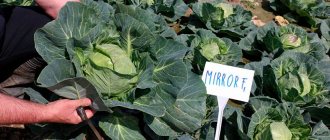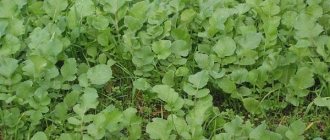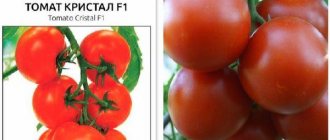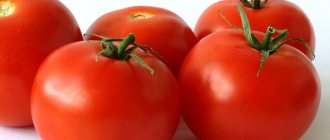White radish came to us from Asian countries and is currently a popular root vegetable. Many gardeners prefer this particular plant variety due to its wide variety of beneficial properties. Growing and caring for white radish does not require much effort, and in this article we will look at all stages of the process - from planting seeds to storing the harvest.
About culture
White radish is an annual (typical for summer and early varieties) or biennial (winter varieties) vegetable crop of the Brassica family. This white root vegetable comes in a variety of shapes: round, elongated or conical.
The vegetable contains the following:
- vitamins A, C, E, H, PP;
- B vitamins;
- minerals: magnesium, calcium, iodine, copper, etc.;
- phytoncides;
- biotin;
- mustard and essential oils.
Dishes prepared from white radish are recommended to be eaten during an epidemic of various viral diseases, and it also promotes rapid recovery of strength. White radish also helps to recover from certain diseases and has rejuvenating properties. This list of advantages makes white radish a must-have guest in your garden beds.
Contraindications.
If you have problems with the heart muscle, limit your use of radishes. Also minimize its use if you have kidney failure. Taste can aggravate diseases.
It is forbidden to eat radish if you have gastrointestinal diseases, because the substances found in the vegetable can worsen the condition.
Pregnant women should also not eat the root vegetable, because it contains essential oils that disrupt the tone of the uterus; this will provoke an early miscarriage, and if the timing is late, the birth of the child will occur prematurely.
You need to remove the vegetable from your diet if you have allergies or individual intolerance.
Before you include radish in your diet, consider not only the benefits, but also find out about contraindications, doses, when you eat it. If you use vegetables correctly, all vitamins and minerals will be absorbed to benefit the health of the body.
Varieties of white radish
The following varieties of white radish are distinguished:
- Daikon. Root vegetables can be up to 60 cm long, valued for their unpretentiousness, and have a sweetish taste. Productivity - 2.5-3 kg per sq.m. The growing season of daikon is up to 60 days.
- Minowasi. Mid-season, has tasty and crispy flesh, slightly spicy, suitable for long-term storage. Shape: elongated cylindrical. Copes well with drought and heat, ripens in 60 days.
- May. The fruits are oval in shape, with a juicy, delicate, slightly spicy taste. This variety is not stored in winter; it is used fresh in summer; the first fruits ripen 50-60 days after germination (early ripening variety).
- Moscow hero. A very early variety of domestic selection, reaches a length of 70-80 cm, is suitable for fresh consumption, and can be stored for a long time. The pulp is juicy, crispy, without bitterness. Forms a harvest in 80-85 days from germination, yield - 16-17 kg per square meter. m.
- Kalancha. Mid-ripening variety (about 70 days), the weight of the vegetable is 700-850 g, cylindrical in shape with white pulp, with a delicate taste with a slight bitterness. The fruits are characterized by good keeping quality.
- Dragon tooth. This is a new mid-season variety with a high yield, not suitable for storage, and the weight of one fruit can reach 1.5 kg. The period from germination to harvest is 60-70 days, the root crops are long and cylindrical in shape. Productivity - 11-13 kg per square meter. m.
- Winter round white. Mid-season radish, has a long shelf life (several months in a cellar), the pulp is juicy, and the taste is medium-sharp. The shape is round. Ripens in 80 to 100 days.
- The Dragon. Mid-season variety - from germination to harvest - 65-70 days. The root crop is cylindrical in shape with a conical slope, weight - 0.9-1.0 kg, the pulp is juicy, tender, white, the taste is sweetish without a pungent aftertaste.
- Rhinoceros. It is an early ripening variety - you can try a salad with this variety at the end of June. Ripening period is 53-57 days. Long root vegetables with a round greenish head have a sweetish, refreshing taste without pungency. Productivity - up to 7 kg per square meter. m.
- Grayvoronskaya. A late, productive variety, with large white fruits up to 50 cm long and weighing up to 2 kg, suitable for long-term storage. The pulp is white, dense, slightly juicy, and has a pungent taste. Productivity - up to 4.5 kg per sq.m. Ripening time is 110-120 days.
- Vakula. Mid-season (ripening in 50-60 days), valued for its long shelf life. The plant produces white and juicy large fruits, the length of which can reach up to 50 cm, they have delicate pulp, without pungency.
- Elephant tusk. Mid-season variety, shape - elongated-cylindrical, length - up to 25 cm in length, color - white, well stored in winter. The taste is juicy, sweet and spicy. Adapted for summer-spring ripening. The period from germination to harvesting is 65-75 days. Productivity - 5-6 kg per square meter. m.
- Sasha. It is an early ripening vegetable (35-45 days), weighing from 100 to 400 g, has a short shelf life, has an oval shape, and has delicate flesh with a spicy-sweet taste. Productivity - 2.5 kg per square meter. m.
Features of use
Whole vegetables or juice from them are beneficial for all family members. To achieve maximum effect, it is recommended to consume the vegetable raw. It supports vital functions of the entire body. For human health it can be used both externally and internally.
During pregnancy
Experts are still arguing on this topic. The vegetable contains biotin, which is involved in the production of new cells. The components included in the product enhance the generation of sex hormones.
Excessive consumption increases the activity of the uterus, which can result in miscarriage.
If you are interested in the question, you can discuss it in more detail with your doctor. You should not get carried away with radishes while pregnant.
When breastfeeding
During lactation, the vegetable is useful for women to eat. The resulting substances will be transferred to the baby from the mother along with breast milk. In this case, increasing the tone of the uterus will not pose a threat to either the mother or her baby. Young children are also allowed to eat vegetables. In this case, it is necessary that the doses be minimal.
When losing weight
The vegetable is available to every person, as it has a low price on the market. This fact does not in any way affect the variety of applications. Therefore, it is very popular among men and women who want to lose weight. The product is devoid of fats and carbohydrates and has a low protein content. Do not get too carried away with a diet based on this product. Radish is used as an emergency short-term remedy for weight loss.
For diabetes
Patients can eat not only root vegetables, but also tops. The green mass contains minerals, vitamins, micro- and macroelements. With the help of tops, you can improve blood circulation and heart function, and remove cholesterol from blood vessels. It also has an antiseptic effect. Tops are added to fresh salads, used as an additional ingredient in soups, main cold and hot dishes.
Compatibility with other vegetables
When growing vegetables in the garden, you may notice that the harvest becomes more scarce from year to year. The reason is the lack of normal crop rotation when planting vegetables. By violating the rules of compatibility, you cannot count on a generous harvest. If you plant compatible crops, you will make the care process much easier for yourself, since they require approximately the same procedures and conditions.
Planting plants that are incompatible with radishes can lead to a number of problems:
- development of fungal infections;
- attracting pests;
- poor development of culture;
- small harvest.
The best predecessors of white radish are legumes:
- lentils;
- peanut;
- beans;
- peas.
But you can plant after such crops:
- cucumbers;
- peppers;
- zucchini;
- greenery;
- eggplant.
You cannot plant radishes after representatives of the Cruciferous family:
- carrot;
- horseradish;
- cabbage;
- beet;
- radish.
After these crops, radish can be planted only after 3-4 years.
Preparing for landing
Radishes can be planted both in greenhouses and in open ground. Each method has its own nuances.
In the greenhouse
Summer varieties can be grown in film greenhouses - they are sown simultaneously with radishes, in early April. Before sowing, the beds need to be dug up and added to each square. m. by:
- 20-25 g of ammonium nitrate;
- 40-50 g of superphosphate;
- 25 g of potassium salt.
Sowing is carried out in rows at a distance of 20 cm and 5-6 cm between plants. Sow to a depth of 1-1.5 cm, per 1 sq.m. sow 2 g of seeds. After this, the crops are covered with spunbond to increase soil temperature and maintain moisture. The spunbond is removed when shoots appear.
The temperature suitable for the emergence of seedlings is 18-20 degrees, after which the temperature is lowered and maintained at 6-8 degrees with the help of ventilation for 3-4 days. Watering should be done every 3-4 days, avoiding drying out, otherwise the radish will bolt. Cleaning is carried out selectively.
In the open ground
Radish can easily tolerate fairly low temperatures down to -3-4 degrees. it is not afraid of frost; even seedlings can germinate when the temperature drops to +3-5 degrees.
Radishes can be planted in both summer and winter. The optimal time for planting is late April - early May. Those varieties that can be stored for a long time should be planted in the second half of June. Early ripening varieties should be sown in July - early August.
A good harvest can be obtained by planting in a properly selected area - you need to find a well-lit place. Radish grows best on fertile loamy soil - this is a light humus soil with an acidity of 6-7 pH. if the acidity of the soil is high, then it needs to be limed, otherwise the plant will get sick and the root crops will begin to deteriorate.
In addition to the soil, you also need to prepare the seeds - select the largest and highest quality ones. Soak the seeds in a saline solution (1 tablespoon of salt per glass of water) to select the best ones, after which the seeds should be transferred to a weak solution of potassium permanganate to prevent diseases.
The landing process itself is as follows:
- Make furrows in the beds at a distance of 30 cm and a depth of 1.5-2 cm.
- Place seeds in nests of 3 in the holes. In this case, the distance between the nests must be at least 15 cm.
- Fill the grooves with soil and compact them a little.
- Water generously and cover with film.
- After 5 or 6 days, leave the strongest shoot in each nest.
Black radish: benefits and contraindications
The benefits of black radish are great. The root vegetable has a rich black color, has a specific taste and pleasant aroma. This type of vegetable is considered the most useful, used in cosmetology and folk medicine, and used in cooking.
Useful properties of black radish:
- improves appetite;
- cleanses blood vessels;
- has a general strengthening effect;
- stimulates metabolic processes;
- normalizes intestinal function;
- used as an antitussive and expectorant;
- black radish and its juice destroy parasites;
- relieves swelling;
- promotes the dissolution of gallstones.
Radish juice (usually black) is used to cure painful urination, as a gargle for toothache, and for gynecological problems. Compresses are used to treat rheumatism, bruises and resorption of bruises.
Important!
However, if you experience discomfort in the stomach, increased acidity, enterocolitis, or individual intolerance to the product, you should know that black radish is not your product. In moderation, the root vegetable can be eaten for problems with the gastrointestinal tract.
Planting methods
As already noted, radishes can be planted both in spring and summer. Pre-winter planting is also allowed when using special varieties of seed. There are 2 main methods of planting: seedless and seedling, we will talk about them below.
Seedless
Sowing white radish seeds is carried out in well-warmed, treated soil, following the following procedure:
- Form planting holes around the perimeter of the bed - row spacing is 60 cm, leave a distance of 30-35 cm between the holes;
- pour 0.5-1 liters of warm water into each hole and sow 2-3 seeds;
- Sprinkle the crops with earth, which must first be lightly compacted;
- at the last stage, mulch the surface of the beds with dry peat.
The seedless method is used for daikon varieties with long roots. In addition, late sowing of the crop is carried out in this way, in late July - mid-August.
Rassadny
For planting in spring, radish seedlings are obtained from seeds at home. To sow white radish seeds, use:
- peat pots up to 0.5 l;
- peat tablets;
- plastic containers at least 10 cm deep.
Neutral and slightly alkaline soil can be used both from the garden and purchased soil for planting vegetables. To plant root seedlings, follow simple instructions:
- fill the pots with soil and moisten it;
- place the seeds in containers and sprinkle with 2-3 cm of soil;
- cover the pots with plastic wrap and leave in a warm place;
- after the first shoots appear, remove the film and place the pots in a lighted place;
- transplant into beds after 3-4 leaves appear.
Before sowing seedlings, it is recommended to remove the weakest shoots from the seeds, which will not give a good harvest.
Calorie content and chemical composition
Radish is a low-calorie product with a composition rich in vitamins, microelements and macroelements, therefore this vegetable crop is very popular in the Lenten menu, and is also widely used in weight loss diets:
- amount of proteins – 1.2 g;
- carbohydrates – 4.1 g;
- dietary fiber – 1.4 g;
- water – 95.4 g;
- monosaccharides and disaccharides – 0.2 g;
- starch – 0.5 g;
- ash – 0.8 g;
- vitamin PP – 2.2 mg;
- vitamin A – 10.0 mcg;
- vitamin B1 – 0.8 mg;
- vitamin B2 – 0.2 mg;
- vitamin B5 – 2.2 mg;
- vitamin B6 – 0.3 mg;
- vitamin B9 – 18 mcg;
- vitamin C – 30 mg;
- vitamin E – 2.1 mg;
- vitamin H – 19 mcg;
- calcium – 27 mg;
- magnesium – 9 mg;
- sodium – 16 mg;
- potassium – 280 mg;
- phosphorus – 28 mg;
- chlorine – 7 mg;
- sulfur – 5 mg;
- iron – 0.84 mg;
- zinc – 0.18 mg;
- iodine – 2.1 mcg;
- copper – 10 mg.
The total calorie content of white radish does not exceed 21 kcal.
Radish care
White radish is not a picky vegetable and does not cause any particular difficulties when growing.
Top dressing
During the entire development cycle of plants, it is necessary to fertilize twice:
- the first time - after the formation and opening of cotyledon leaves;
- the second time - a week after the first feeding.
Due to the short ripening time of early varieties of radish, they need to be fed only with nitrogen-containing fertilizers. For example, 0.2% sodium or lime-ammonium nitrate.
Late-ripening varieties are fertilized once a week with a solution of mineral fertilizers (60 g of superphosphate, 20 g of urea and 15 g of calcium chloride). In this case, a bucket of water is consumed per 20 m row. The plant needs nitrogen in large doses, so complex fertilizers need to be alternated with nitrogen fertilizers. 3 weeks before harvest, all fertilizing should be stopped.
Manure is not used for feeding, as it “stimulates” the division of vegetables.
Thinning
Thinning is a necessary procedure because thickening of crops increases the risk of flower stalks, deformation and hardening of fruits.
First, you need to thin out after a pair of true leaves has formed - the plants can be removed completely or pinched, leaving a distance of 8-10 cm. Next, the radish is thinned out in the formation phase of 4-5 leaves at a distance of 12-15 cm, for winter varieties - 20 cm.
Watering
Watering of early-ripening varieties should be carried out 2-3 times a week, and autumn radish is moistened less often - only 4-5 times during the entire season. Radishes need abundant watering - 11-13 liters per square meter.
The main condition for watering is regularity, because abundant moisture after a long drought can lead to cracking of the root crop, and from a lack of water the pulp becomes hard and wooden. Mulching helps conserve water and minimize the frequency of watering.
Radish processing
If radish is affected by fungal diseases, it should be sprayed with a product that contains copper, for example:
- Bordeaux mixture;
- copper oxychloride;
- copper sulfate.
The bushes must be treated strictly according to the instructions presented on the packaging of the product. If the radish has been affected by mosaic, then the plants affected by it must be removed from the ground and destroyed to avoid disease of neighboring bushes.
To get rid of pests, it is necessary to treat the beds with insecticidal preparations, which can be purchased in specialized stores. But the main method of protecting the crop from diseases and parasites is to treat the seed material and soil before sowing, and also remember the rules of crop rotation and agricultural technology for white radish.
What is the difference between black radish and white radish?
Black radish is common in Europe and America. The green one, first bred in Uzbekistan, is grown in Asia. Black radish has a dark skin and completely white flesh inside, has a sharp taste and is very tough, so it is mainly used in salads and seasonings for meat dishes. Its main use is in cosmetics or medicines. Green radish has a green tint to the skin and fruit, but its taste is much milder and not bitter. It is often used in cooking, fried, and made into chips.
In Japan, a special variety of radish was developed - white, also known as daikon. It has a pleasant taste, is not bitter and contains the same set of vitamins and minerals as black and green radish. In addition to its taste, daikon also has an unusual shape; its fruits are long and elongated.
Which is healthier?
Of the three main varieties, black radish is considered to be the richest in nutrients. However, white does not contain mustard oils, which give a sharp taste and have a strong effect on the stomach. Therefore, it is believed that white radish is more beneficial for the body.
Diseases and pests
The radish’s belonging to the Cruciferous family determines the list of diseases and pests dangerous to it:
- Cruciferous flea beetle . It is capable of destroying all foliage on plants, which causes disruption of photosynthesis and inhibition of root growth.
- Cabbage _ It lays eggs in radish leaves, and the caterpillars that emerge from them in a short time are capable of destroying the tops, which causes the death of the plants.
- Cabbage fly . Dangerous for early varieties that ripen in May. Flies lay eggs in the soil near cruciferous crops. The larvae feed on the roots of the plant, which leads to the death of radish seedlings.
- Slugs . Dangerous for ripening root crops. They come out at night and infect the stem and the part of the radish protruding above the surface.
- Bacteriosis . A viral disease that is caused by excess water in the soil. There are two types - vascular and mucous.
- White rot . Damage and discoloration of tissues.
- Powdery mildew . It affects petioles and leaves, sometimes stems.
- Black leg . Fungal infection of the upper part of the root crop and the lower part of the leaf rosette.
Shooting problem
There are situations when the radish, instead of releasing fruits, begins to bush heavily and shoot out arrows. There are several reasons for this:
- The planting time does not meet the requirements of the variety;
- extreme heat, insufficient watering;
- overuse of organic fertilizers.
If the radish shoots out an arrow, then you need to say goodbye to it - the root crop will turn out to be tough and underdeveloped. Sometimes a couple of such flowering plants may leave seeds to ripen for further propagation. But bolting plants are not suitable for food.
The appearance of an arrow means that you need to reconsider your care - if the planting date is chosen too early, then you can save the harvest by artificially shortening the daylight hours (covering the bed).
If the reason for the appearance of shoots is heat, then you can avoid the situation by morning and evening watering in small volumes - this stimulates the growth of root crops.
It is more difficult to reduce the nutritional value of the soil, but you can try to acidify the area - to correct the pH, you can water the radish with a solution of citric acid at the rate of 2 tbsp. l. on a bucket of water. The resulting liquid is applied by uniform watering no more than twice during the entire development period.
Useful properties of black, white and green radish. Radish recipes for coughs and colds
More than one generation of our ancestors cured colds and increased immunity with the help of a simple garden vegetable - radish. Currently, there are several varieties of radish. We will try to find out the benefits and harms of white, black and green radishes with the help of this article.
Depending on the mentality of the country, the priority of radish had a different status among our ancestors. In ancient Egypt, it was fed to slaves to maintain physical strength.
In Greece, the radish was personified as a divine vegetable worthy of Apollo, which was brought as a gift to his altar. The Slavs have long been preparing delicacies for the festive table; any ordinary meal would not be complete without radishes.
What's special about such a simple and familiar product? There are several types of radish. Let's look at some of them.
The benefits and harms of white radish
White radish
A striking representative of the white radish is daikon. Juicy, dietary radish fruits contain a huge amount of vitamin C. By eating daikon throughout the day, you can replenish the body’s daily need for vitamins by eating just a hundred gram piece of this root vegetable.
White radish heals the liver and kidneys. Sand and stones are removed using recipes prepared with daikon. Thus, these organs are cleansed.
The white root vegetable contains a high content of phytoncides. They strengthen the immune system and reduce the risk of various infections. Purulent wounds and inflammations are treated by applying the raw vegetable.
The list of uses of daikon in folk medicine is wide; it is used for treatment
- liver and stomach
- gallbladder
- elevated temperature
- cancer
- skin
- leukoderma
- kidney
- respiratory system diseases
- bites of various insects
- genitourinary problems
- weight loss
White radish has minor contraindications; the essential oils and enzymes it contains can cause allergies. If you eat a lot of daikon, there may be problems with the intestines, bloating and abdominal pain may appear.
If you have intestinal problems, it is better to consult a doctor before using it.
This product is used to prevent colds.
The root vegetable helps the body adapt after serious illnesses.
The benefits and harms of black radish
Black radish
Not entirely pleasant to the taste, but the healthiest of all types is black radish . Having no other methods of treatment other than natural medicines, our grandmothers used it both for external use in the form of compresses and rubbing, and to eliminate problems of internal organs.
Patients suffering from cough were treated by applying a compress of ground root vegetables. They put juice in the nose. We made compresses for various ear diseases. Healers at that time already knew how harmful parasites were to the body and used radishes to save themselves from them.
The benefits of radish, thanks to the lysozyme it contains, successfully fights bacteria during colds.
The properties of this vegetable are used for treatment
in the form of compresses
- for resolving bruises
- rheumatism treatment
- treatment of bruises in the form of juice
- colds to improve immunity
- From cough
- as a rinse - to relieve toothache
- for internal use - for the treatment of cystitis
- with painful, frequent or delayed urination
- for gynecological problems, scanty or too heavy menstruation, frequent delays
The use of radish will not harm a healthy person. Use is contraindicated in case of cardiovascular diseases, severe liver and kidney damage.
Moderate use of radish for diseases of the gastrointestinal tract: gastritis, enterocolitis, ulcers.
In the absence of these diseases, if you feel discomfort in the stomach, even a healthy person should refuse such a tasty and healthy vegetable.
The benefits and harms of green radish
Green radish
This variety has several names: green, Chinese, “lobo”, Margelan radish. The composition of this root vegetable is similar to black radish. But the taste is milder.
Beneficial properties of green vegetables:
- help improve appetite by activating the gastrointestinal tract
- has a healing effect in case of visual impairment - vitamin A
- Potassium, sodium, phosphorus, sodium and iron minerals contained in radishes increase immunity and reduce high blood pressure
- Vitamins B and PP help with diseases of the nervous system. Which also stimulate protein metabolism
- helps with anemia, high iron content
- Potassium contained in the lobo improves the condition of teeth and bone mass
- In order to prevent constipation, this useful product is very useful
- blood sugar levels are stabilized due to the nutrients of the Chinese vegetable
- effective in treating whooping cough
- has a choleretic agent, effective for problems with the gallbladder and liver
- Regular use of lobo reduces cholesterol levels
- promotes the removal of harmful substances from the body
- relieves discomfort due to dysbacteriosis
- Radish juice treats baldness and hair loss
- compresses are used for gout, radiculitis, joint diseases
The general contraindications for green root vegetables are the same as for black and white ones. But due to the fact that it has a lower content of phytoncides than black, this medicinal vegetable can be used for some gastrointestinal diseases.
Which radish is healthier?
Black radish is very pungent and bitter, but it is the most beneficial. Its composition promotes a speedy recovery, but it is only suitable for those who do not have stomach problems. White radish is more suitable for salads. Despite this, it effectively fights colds. It destroys infections well and improves immunity due to the high content of phytoncides. Green radish for lovers of spicy food. It is suitable for almost all people except those who are obese. The benefits and harms are very harmoniously located in it. There is practically no bitterness in it, and therefore no phytoncides, but this is compensated by other useful substances. It helps produce gastric juice, which increases appetite.
Benefits of radish for women
Considering the positive effect of radish in solving problems with the genitourinary system, its properties have a remarkable result in the treatment of cystitis. This root vegetable copes well with problems in gynecology, numerous or scanty discharge during menstruation, and delays in the cycle.
A wide range of uses for radish has also found itself in cosmetology for women.
Whitening extract
- Pour half a glass of radish chopped in a blender with a glass of apple cider vinegar.
- Place in a dark, warm place for at least two weeks, shaking occasionally
- Squeeze the finished root vegetable
- Strain the resulting elixir
- Dilute with a liter of filtered water
- Cleanse your face in the morning and evening Compress for aging facial skin
- Add a quarter cup of sour cream and the same amount of honey to a small grated radish.
- Stir
- Apply a thick layer to exposed parts of the face, neck, and décolleté area.
- After the mask dries, wash off with warm water Eye mask
- Place thinly sliced radish under the eyes for 15 minutes.
- Wash off with warm water
Cleansing scrub
- Mix equal parts grated radish, grapefruit and sea salt.
- Cleanse the skin of the face and body once or twice a week
Strengthening mask against hair loss
- Pour 75 grams of chopped burdock root with 10 grams of boiling water
- Cool
- Juice of onions and radishes taken equally
- Add the same amount of cognac
- Combine the strained burdock with the prepared mixture
- Rub into the roots of the hairline
- Wrap in a thick towel
- For best effect, leave overnight
- Used for baldness in men, hair loss in women
Benefits of radish for men
Radish has a positive effect on the treatment of the genitourinary system of women and men. Therefore, this root vegetable helps men with prostate problems.
How to cook radish with cough honey?
Radish with honey for cough
To effectively treat cough, prepare radish juice mixed with honey.
1 way
- Cut off the top of the root crop
- Cut out the middle, leaving the walls
- Fill the resulting void with honey
- Close with the cut “lid”
- We stand for 24 hours
- Drink the released medicinal juice a small spoon at night, in case of severe cough, increase the consumption to three times a day
Method 2
- Peel the radish
- Add half a glass of honey to the resulting mass.
- Leave for at least two hours in a warm place
- Squeeze the infusion and take it in the same proportion as in the above recipe
In parallel with taking the juice, you can apply a compress of black grated radish, wrapped in thick cloth, applied to the chest for 15 minutes
Can children eat radishes?
Can children eat radishes?
Young children are susceptible to various infectious diseases. Radish is given to children to increase immunity and to fight cough. This is a very effective and safe remedy.
If the child has no other diseases other than colds, radish can be used without fear.
Can radishes be consumed by pregnant women?
Any type of radish listed above is not recommended for pregnant women. The high content of essential oils contained in this root vegetable tends to accumulate in the body.
The result of this process may be the threat of miscarriage, given the tone of the uterus. Therefore, it is better for pregnant women to take other folk remedies for cough.
Why radish helps: tips and reviews
Tatyana: I know a great way to lower blood sugar: mix about three kilograms of green radish with half a liter of alcohol or vodka. Keep for forty days in a dark, cool place. Preferably in glass containers. We drink for a long time for at least a month. Break 10 days. Every day before eating a full canteen Marina: I tried it on myself when I had no physical and moral strength to do anything. Vigorous, but effective: Take three or four tablespoons of fresh radish juice every hour with water.
The benefits and harms of radish
When treating any disease, it is important to remember the existing contraindications. It is better to play it safe and refuse the medicinal products of this miraculous balm than to cause harm.
Video: Folk remedies for cough: the benefits of radish
Harvest and storage
The collection of early varieties of radish, which was grown in a greenhouse, begins at the end of May - you need to dig up root vegetables that have reached 3-4 cm in diameter. The remaining vegetables are sorted as they ripen all summer.
Plants of mid-season varieties, sown in early June, are dug up at the end of August. Winter radishes can be harvested in late autumn, but the weather must be dry and frost-free. Daikon is usually dug up in October.
Shake off the soil from the dug up root crops, remove small roots, and cut off the tops. Before storing, vegetables are inspected and damaged root crops are discarded.
Summer radishes are stored in boxes or plastic bags with holes:
- indoors – a week;
- in the refrigerator - up to 20 days.
Autumn and winter varieties are placed in a box and covered with wet sand. Keep radishes either in the refrigerator or in the basement.
The storage temperature should be 1-3 degrees, humidity – 80-90%. The shelf life of this radish is 200 days. In the basement, radishes should be kept next to carrots and potatoes.
The popularity of white radish is only gaining momentum every year - almost every gardener tries to grow a bed of this vegetable, which has impressive beneficial properties. Knowing the basic rules for planting vegetables, it will not be difficult for you to plant radishes in order to subsequently get an excellent harvest.
0
0
Copy link
Beneficial features
The medicinal properties of white radish have been known to man for a long time.
The vegetable is used for the following purposes:
- treatment of diseases;
- cooking;
- healing of the body.
White radish is useful because it contains phytoncides, which stimulate the immune system, thereby improving defense functions. Due to their content, the vegetable has a bitter taste. A person should periodically consume the root vegetable.
White radish juice is taken by people who do not want to get the flu or cold, or catch an infection or virus.
Radish will be useful for women for cosmetic purposes. The composition of the product is rich in chemical elements. Radish helps fight many skin imperfections. It can reduce age spots, and with long-term use, get rid of them.
It brings particular benefits to the body for people over 35 years of age. The vegetable has a rejuvenating effect. It can improve blood circulation, increases the tone of the skin, making it more elastic. Indicated for men and women, as it helps the body recover faster from depression, infectious or colds.
What are the benefits of radish besides the above? If you mix vegetable juice with honey, you get a remedy for the treatment of cholelithiasis, as well as diseases of the urinary system and respiratory tract. The liquid helps a person get rid of radiculitis and rheumatism. Vegetable juice eliminates small wounds, ulcers, ulcers and eczema.
A large amount of essential oil and ascorbic acid in the composition promotes urine excretion and cleansing of the kidneys. The vegetable is unique in composition and contains 10 valuable amino acids. The product is considered dietary because it has a minimal amount of carbohydrates and fats. Because of this, it is one of the most beloved, especially among women.
See also
Review of the best daikon varieties for open ground and winter storageRead











